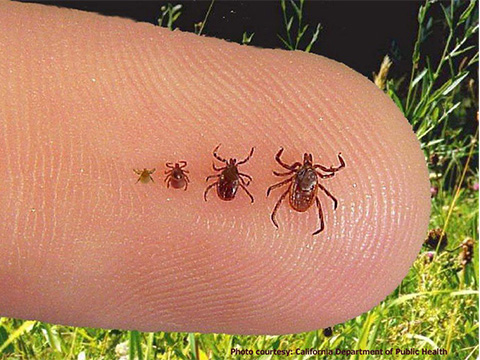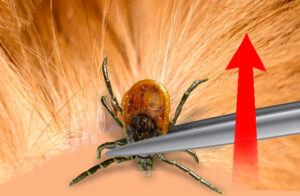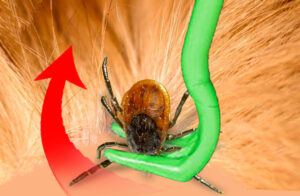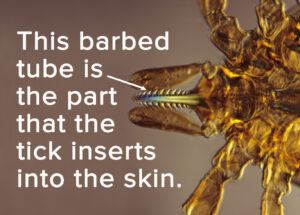
It’s tick season and where I live it seems like they’re everywhere. When you’re out jogging or playing with your dog there’s a good chance one or more may latch onto you or your pup.
It’s important to get rid of the ticks ASAP. Lyme disease, babesiosis, and ehrlichiosis are among the infectious diseases they can carry. Transmission of these diseases can happen within 6 hours of tick contact, though most experts say it takes more like 24 hours.
Is your dog comfortable with a full body check?
Hopefully, your dog is at ease with you giving him/her a thorough once-over. Some dogs aren’t comfortable with their privacy being invaded by an ear-belly-toes-legs-groin-butt inspection. You can train them to put up with it by rewarding them with their favorite treat while touching them. During this training only reward them when your hands are on them.
This “hands-on” training may take a while but it’s important that your dog lets you take care of them in this way. Tick removal, ear drops, grooming, nail trimming all require that your dog stay calm while you’re helping them.
Where to look
Though a full-body inspection is needed, there are places where you should pay special attention. As your dog walks or runs their legs and belly come into contact with tall grass or plants where ticks are waiting. So the underside (from throat to groin, including between toes and legs/armpits) are prime tick targets.
Of course, dogs are always using their sense of smell to see the world. That means putting their face into almost every bush they pass by. My dog seems to get ticks in the bushy hair above her eyes. Also, ears, inside and out, are especially prone to tick bites. Maybe because there’s an abundance of blood flow there. Remember that the inside of a dog’s ears are mostly exposed skin and are therefore easier for a tick to attach.
Ticks can be hard to see. There are approximately 200 species of ticks and they come in a wide range of sizes. The tiniest ones (about the size of a period here) can be one of the most dangerous as they can carry Lyme disease. You can feel your dog’s coat for bumps and then examine the bump. Of course, this gets harder when there are tiny ticks.

Procedure
Once you locate a tick you’ll need a pair of tweezers. Most household tweezers are too thick and blunt. Tick removal requires thin, pointy tweezers so you can get close to the skin. This will give you the best chance of not breaking off the mouthparts and leaving them in the skin, possibly causing an infection.
 Position the tweezers as far to the front of the insect as possible without pinching the dog’s skin. Squeeze tightly, and pull straight upwards – away from your dog’s skin.
Position the tweezers as far to the front of the insect as possible without pinching the dog’s skin. Squeeze tightly, and pull straight upwards – away from your dog’s skin.
There’s also another great tool for tick removal. It’s called a tick hook, or tick stick. Instead of a pinching action, as with the tweezers, it’s a flat surface with a “V” shape cut in it.
 Slide the tick into the smallest part of the “V”, then pull up, away from the skin. Some versions are angled or curved leading into the handle. This can help you use leverage as you pry the tick off of your pup like a crowbar.
Slide the tick into the smallest part of the “V”, then pull up, away from the skin. Some versions are angled or curved leading into the handle. This can help you use leverage as you pry the tick off of your pup like a crowbar.
Another trick that is said to often work is putting a cotton ball soaked in rubbing alcohol on the tick, causing it to loosen its hold on the skin and back out. Then you can just pick it off. This seems safe to try. If it doesn’t work, at least you’ve sterilized the area.
If you don’t have tweezers or the tick hook, some people say dental floss can work. Loop it around the tick as close to the skin as possible and pull upwards. This might be a good choice if the tick is close to your dog’s eyes. Thin, pointy tweezers can be a hazard if your pup jerks unexpectedly.
Don’t do this
Growing up I’d always heard that you should light a match, blow it out, and touch the still very hot ember to the tick’s back end. Or use a lit cigarette in a similar fashion. In theory, this would cause the tick to back out, releasing it’s hold on the skin. It didn’t work for me. I tried it. Not on my dog, but on myself. Too hot, too dangerous, and not effective.
I also heard that you could cover the tick with petroleum jelly or nail polish. This was supposed to deny the insect oxygen, again forcing it to release. These allow the tick to stay on your dog longer and make it harder to pull off the correct way.
Don’t try to use your fingers. Chances are that you’ll squash the bug and increase the chances of infection or disease transmission.
Tick Disposal
Once you have the tick, put him in a cup of rubbing alcohol. They can survive if flushed down the toilet and they’re almost impossible to crush. You can keep the dead insect in a baggie for a while. If your dog develops any illness the vet may be able to analyze the tick, identify its species and disease.
There are people that study ticks and Lyme disease. You could possibly help to fight the little critters and the diseases they carry by reporting your encounter. One way is to take a photo of the tick and report it to the University of Rhode Island’s TickEncounter Resource Center.
Were parts of the tick left in the skin?
The mouthpiece that ticks insert to suck blood has harpoon-like barbs. When you pull the bug out it’s very easy to break off this mouthpiece leaving it in the skin.
This is pretty common. You shouldn’t worry too much. The risk of disease transmission is minimal at this point. The mouthparts will probably be worked out of the skin like a splinter, dissolve, or be covered over with skin leaving a small bump.
After removal of the tick sterilize the area with hydrogen peroxide or rubbing alcohol. You can put antibiotic cream on the site as long as it’s not in an area where your dog will just lick it off. Keep an eye on the area and look for signs of an infection or rash. If that happens consult your vet.
This Video from NPR explains a lot about ticks
Tick prevention?
Tick removal is pretty disgusting and we’d all like to avoid it. So how can we keep the little vampires from biting our best friends? There are a lot of medications that your vet will offer you, both topical and oral. Most of these meds are chemicals that may ward off ticks, and can possibly have side effects. My dog is prone to seizures and some of these meds are believed to bring them on.
We always say consult your vet. Your dog’s health is your vet’s concern. However, they make quite a bit of money on the very expensive flea and tick remedies and this may be a conflict of interest.
There are natural remedies. Garlic cloves can help (haha… use garlic to repel the tick vampires!). Use finely diced fresh organic garlic every day. Let the diced garlic sit for 10 minutes before adding it to your dog’s meal. Big dogs can tolerate two cloves of garlic daily. Smaller dogs should only have one small clove. The garlic is secreted out through your dog’s pores and into its coat. When giving your pup a shampoo use one that’s natural and gentle so you keep the garlic protection active.
Resources for natural bug remedies:
Guardian’s Choice Pet Natural Flea Deterrent
BugMD Flea & Tick Concentrate
Only Natural Pet Flea / Tick Repellent

